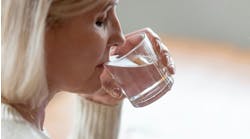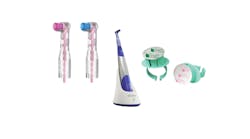by Karen Kaiser, RDH
Fresh baked cookies are always a delectable treat. Many cookie bakers follow a special recipe. The recipe may have been passed down from a great-grandmother, discovered in a well-worn cookbook, or carefully clipped from a magazine. Wherever the recipe is found, that slip of paper is certain to become a treasured recipe when the cookie becomes a hit. Measuring, mixing, and kneading the flour, sugar and butter together with the other ingredients to form the tasty dough mix makes for the start of a great cookie. Once the dough is prepared, chocolate chips, raisins, and nuts may be added to the basic mix. By rounded spoonful, the cookies are dropped onto a cookie sheet or rolled and cut into shapes. The preheated oven bakes the dough into a soft treat. As the oven timer shrilly dings the elapsed cooking time, the fit-to-be-eaten cookies are ready to be removed from the middle rack. With a pot holder, the cookie sheet is grasped, but the wrist inadvertently brushes the lip of the hot oven rack.
Look to the windowsill. The aloe vera plant grows there, ready to relieve the pain of the burn.
The aloe vera plant sitting on your sill has a potent curative effect for minor sunburns, small cuts, and slight scrapes. The succulent leaf of the aloe vera plant has been used medicinally for centuries. The aloe sap promotes healing, reduces inflammation, and offers pain relief. Aloe vera is also found as an ingredient in numerous medicines and cosmetic goods. Products such as shampoos, sunscreens and sunburn relief gel, skin lotions, hand soaps, and body moisturizers lay claim to having aloe vera as an ingredient.
Numerous products are used in dentistry that require maintaining moisture. It makes sense to take a logical look at how aloe vera has become a natural component worth integrating into the dental practice. The dental uses of aloe vera are topically or intraorally applied.
Mouth sores, abrasion caused by braces, denture irritation, and self-inflicted cheek bites are very uncomfortable to endure. At times, specifically locating the irritated area and applying medicaments may not be easy for the patient. For the patient bothered by encompassing pain, an over-the-counter rinse that easily coats the entire mouth — rather than trying to ineffectively locate the painful point — would be the ideal mode of delivery for generalized discomfort. Rincinol P.R.N. (Sunstar Americas) is an example of such a remedy.
Rincinol P.R.N. shields the exposed nerve endings that cause the pain and lessens stimulation, thereby easing the pain. This oral soother contains aloe vera and forms a protective gel barrier over the irritated site as it hydrates to heal the tissues.
When patients experience recurring ulcerations, such as aphthous ulcers, having a full rinse product that offers rapid, nonstinging relief would be welcomed. A survey of first-time users in a United Kingdom dental practice in February 2003 summarized the rinse for mouth ulcerations as averaging an onset of relief time of 3 minutes and 14 seconds and lasting a remarkable 330 minutes or more than five hours. Eighty-five percent of the survey respondents also commented that the oral rinse was easy to use.
In May 1998, at Serravelle Health Centre in the Republic of San Marino, a clinical evaluation on the safety and efficacy for treatment of pain caused by aphthous ulcers was studied on the rinse. The participants had at least one (single) ulcer with most of the painful ulcers located on the inner lip surface, gum tissues, tongue, and buccal mucosa. They were instructed to rinse three times a day with the product. After the first use of the rinse, participants stated they experienced a reduction in pain upon speaking and eating, and no side effects were noted.
Rincinol P.R.N. has a wide range of applications chairside. This rinse is suitable for rinsing after soft tissue procedures and root planing, as well as after soft-tissue laser procedures or orthodontic treatment.
For a site-specific spray option, Ameseal Oral Lesion Spray is offered by OMNI Preventive Care, a 3M ESPE Company. This relief spray, which contains aloe vera extract, does not burn on application and is applied directly to the lesion using an attachment sprayer that targets the injury. The product is supplied in a 15ml bottle, enough for 100 squirts. The attachment is long enough at 2 1/2 inches to be accurately aimed at the posterior areas in the mouth, coating the mucosa with a protective, pain-relieving film. Ameseal is not available as an over-the-counter preparation, only available as a professionally dispensed product.
Another comforting spray combines aloe vera with the oral benefits of xylitol. Oral Guard comes from the Institute of Vibrant Living and is 100 percent all natural. One spray from the two-ounce bottle will start to protect the tissues, and the Oral Guard boasts up to 300 spray uses per container. This formula is designed to reduce bacterial counts leading to periodontal infection. The spray is simple to use. Oral Guard is pump-sprayed along the teeth and gumline, and then briefly left to settle in the mouth. Once the product has sufficiently covered the oral cavity through the spray process, the tongue then moves the concentrated preparation mixing with saliva moisture to amply coat the tissues before the product is expectorated.
When tissues are in need of speedy healing, formulas that have proven continued relief by incorporating aloe vera may be just the right solution. Orally applied aloe vera products dispensed in a rinse or spray can protect and ease some of the painful oral conditions associated with dental treatment. For easing minor discomfort from comprehensive periodontal procedures, soft tissue lasers, or orthodontic therapy, look to the windowsill for a natural ingredient added to the recipe for relief.
Next month's column will feature other benefits of aloe vera available for both hand and home-care products. For more information on the products above, visit www.Sunstarbutler.com, www.solutions.3m.com, and www.instituteforvibrantliving.com.
References
Survey of Aloclair users in a Dorset Dental Practice February 2003, Melanie Coward BDS UK.
A Clinical Evaluation of the Safety and Efficacy of Aloclair for the treatment of pain caused by aphthous ulcers, Serravelle Health Centre, Republic of San Marino, May 1998.
About the Author
Karen Kaiser, RDH, graduated from St. Louis' Forest Park dental hygiene program in 1994 and currently practices at the Center for Contemporary Dentistry in Columbia, Ill. She has written several articles for RDH and other publications, sits on dental hygiene panels, and is an evaluator for Clinical Research Associates. She can be contacted at [email protected].





